NRSG353 Case Study: Cushing's Syndrome - Patient Assessment and Care
VerifiedAdded on 2023/01/12
|8
|1891
|77
Case Study
AI Summary
This case study explores Cushing's Syndrome, a health condition characterized by elevated cortisol levels. The assignment outlines the disease, its causes (including exogenous factors like corticosteroid use), incidence, and risk factors, such as age, gender, and pre-existing health conditions like diabetes. It delves into the impact on patients and their families, highlighting potential mental and psychological effects. The study analyzes key symptoms like skin problems, facial plethora, and bone changes, explaining the underlying pathophysiology of each. It discusses the pharmacodynamics and pharmacology of statins, a relevant medication for managing associated health issues. Furthermore, the assignment details nursing interventions, including patient assessment, diagnosis, planning, implementation, and evaluation, covering aspects such as fluid balance, hygiene, fall prevention, cholesterol level monitoring, emotional support, and patient education. The case study provides a comprehensive overview of the disease and its management in a nursing context.
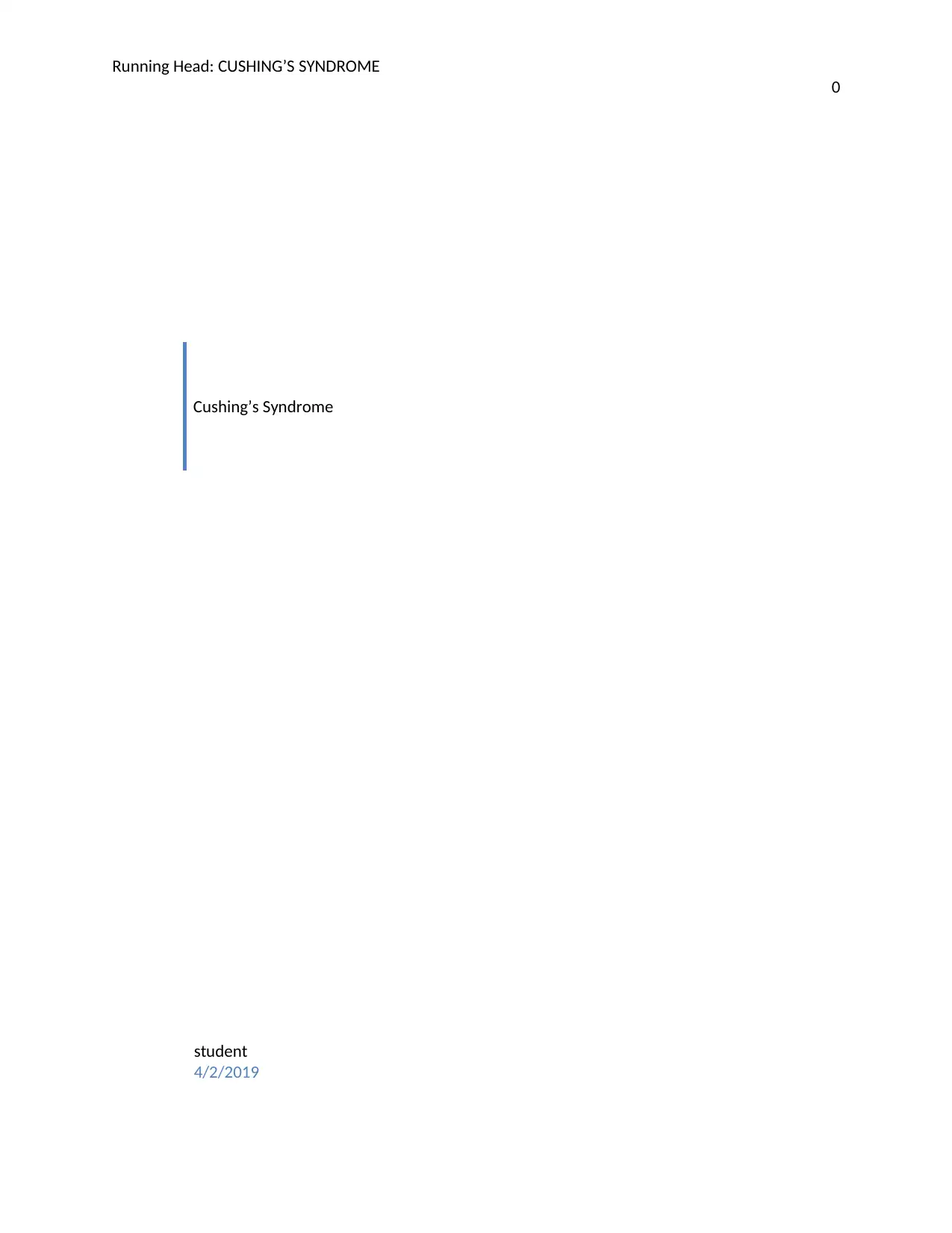
Running Head: CUSHING’S SYNDROME
0
Cushing’s Syndrome
student
4/2/2019
0
Cushing’s Syndrome
student
4/2/2019
Paraphrase This Document
Need a fresh take? Get an instant paraphrase of this document with our AI Paraphraser
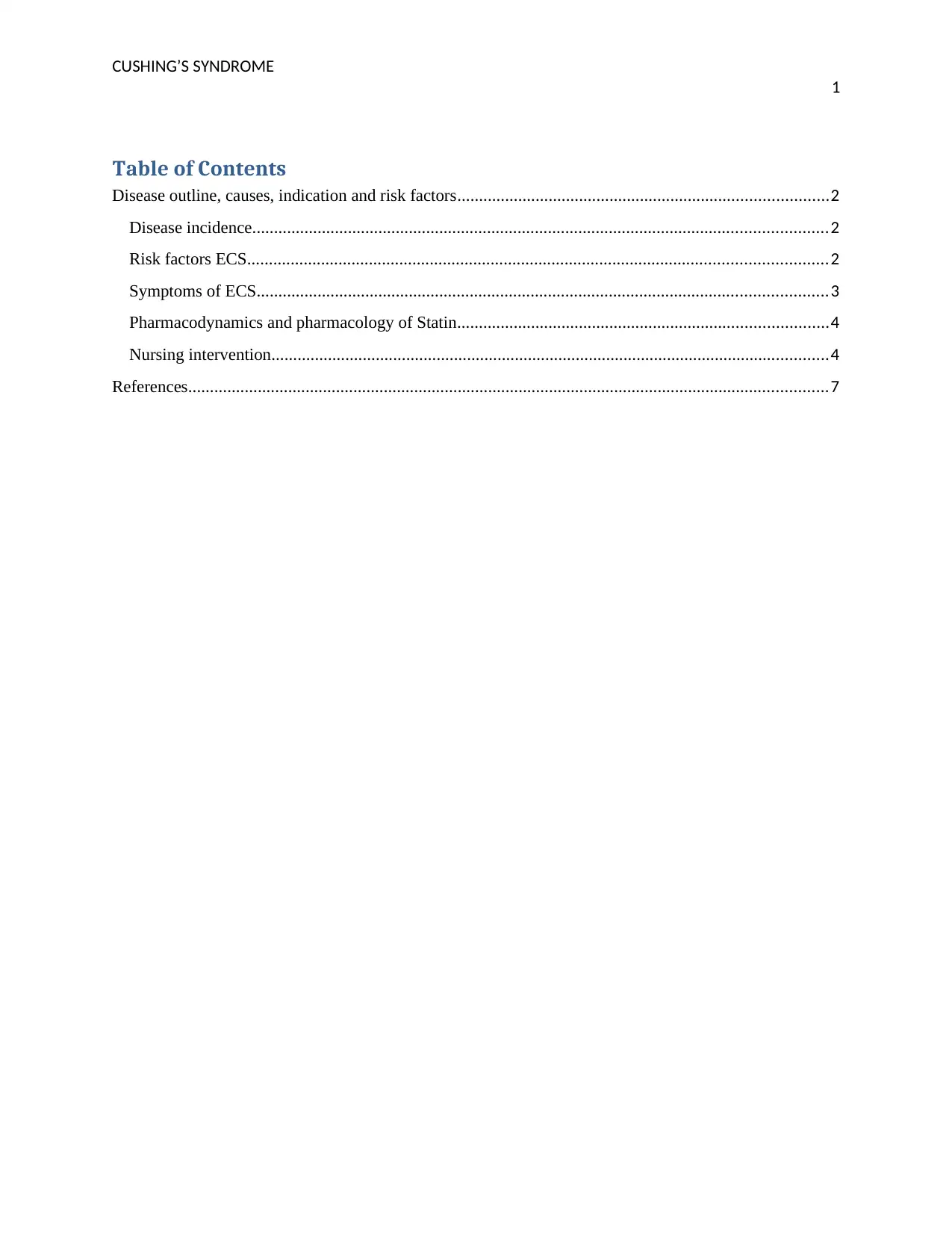
CUSHING’S SYNDROME
1
Table of Contents
Disease outline, causes, indication and risk factors.....................................................................................2
Disease incidence....................................................................................................................................2
Risk factors ECS.....................................................................................................................................2
Symptoms of ECS...................................................................................................................................3
Pharmacodynamics and pharmacology of Statin.....................................................................................4
Nursing intervention................................................................................................................................4
References...................................................................................................................................................7
1
Table of Contents
Disease outline, causes, indication and risk factors.....................................................................................2
Disease incidence....................................................................................................................................2
Risk factors ECS.....................................................................................................................................2
Symptoms of ECS...................................................................................................................................3
Pharmacodynamics and pharmacology of Statin.....................................................................................4
Nursing intervention................................................................................................................................4
References...................................................................................................................................................7
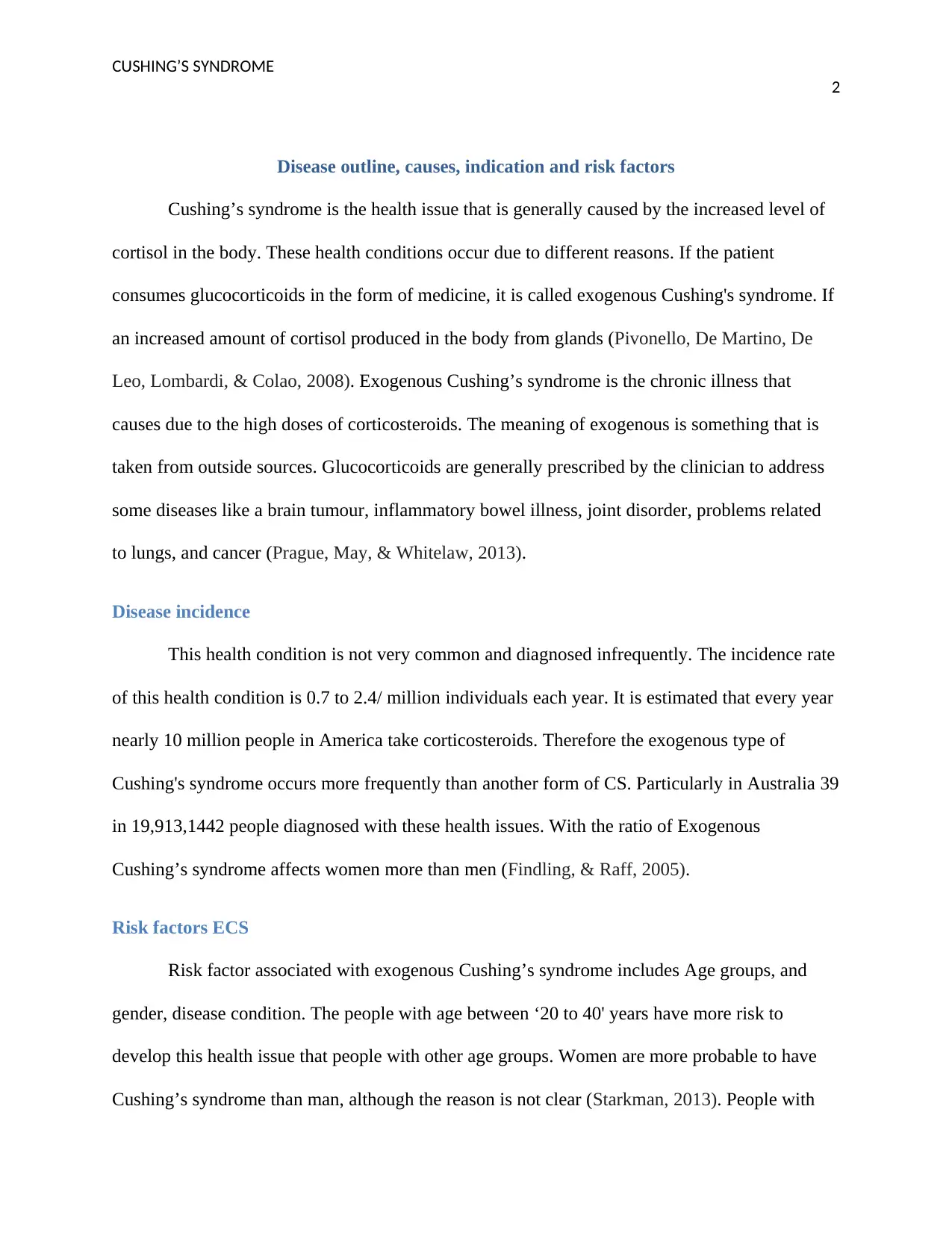
CUSHING’S SYNDROME
2
Disease outline, causes, indication and risk factors
Cushing’s syndrome is the health issue that is generally caused by the increased level of
cortisol in the body. These health conditions occur due to different reasons. If the patient
consumes glucocorticoids in the form of medicine, it is called exogenous Cushing's syndrome. If
an increased amount of cortisol produced in the body from glands (Pivonello, De Martino, De
Leo, Lombardi, & Colao, 2008). Exogenous Cushing’s syndrome is the chronic illness that
causes due to the high doses of corticosteroids. The meaning of exogenous is something that is
taken from outside sources. Glucocorticoids are generally prescribed by the clinician to address
some diseases like a brain tumour, inflammatory bowel illness, joint disorder, problems related
to lungs, and cancer (Prague, May, & Whitelaw, 2013).
Disease incidence
This health condition is not very common and diagnosed infrequently. The incidence rate
of this health condition is 0.7 to 2.4/ million individuals each year. It is estimated that every year
nearly 10 million people in America take corticosteroids. Therefore the exogenous type of
Cushing's syndrome occurs more frequently than another form of CS. Particularly in Australia 39
in 19,913,1442 people diagnosed with these health issues. With the ratio of Exogenous
Cushing’s syndrome affects women more than men (Findling, & Raff, 2005).
Risk factors ECS
Risk factor associated with exogenous Cushing’s syndrome includes Age groups, and
gender, disease condition. The people with age between ‘20 to 40' years have more risk to
develop this health issue that people with other age groups. Women are more probable to have
Cushing’s syndrome than man, although the reason is not clear (Starkman, 2013). People with
2
Disease outline, causes, indication and risk factors
Cushing’s syndrome is the health issue that is generally caused by the increased level of
cortisol in the body. These health conditions occur due to different reasons. If the patient
consumes glucocorticoids in the form of medicine, it is called exogenous Cushing's syndrome. If
an increased amount of cortisol produced in the body from glands (Pivonello, De Martino, De
Leo, Lombardi, & Colao, 2008). Exogenous Cushing’s syndrome is the chronic illness that
causes due to the high doses of corticosteroids. The meaning of exogenous is something that is
taken from outside sources. Glucocorticoids are generally prescribed by the clinician to address
some diseases like a brain tumour, inflammatory bowel illness, joint disorder, problems related
to lungs, and cancer (Prague, May, & Whitelaw, 2013).
Disease incidence
This health condition is not very common and diagnosed infrequently. The incidence rate
of this health condition is 0.7 to 2.4/ million individuals each year. It is estimated that every year
nearly 10 million people in America take corticosteroids. Therefore the exogenous type of
Cushing's syndrome occurs more frequently than another form of CS. Particularly in Australia 39
in 19,913,1442 people diagnosed with these health issues. With the ratio of Exogenous
Cushing’s syndrome affects women more than men (Findling, & Raff, 2005).
Risk factors ECS
Risk factor associated with exogenous Cushing’s syndrome includes Age groups, and
gender, disease condition. The people with age between ‘20 to 40' years have more risk to
develop this health issue that people with other age groups. Women are more probable to have
Cushing’s syndrome than man, although the reason is not clear (Starkman, 2013). People with
⊘ This is a preview!⊘
Do you want full access?
Subscribe today to unlock all pages.

Trusted by 1+ million students worldwide
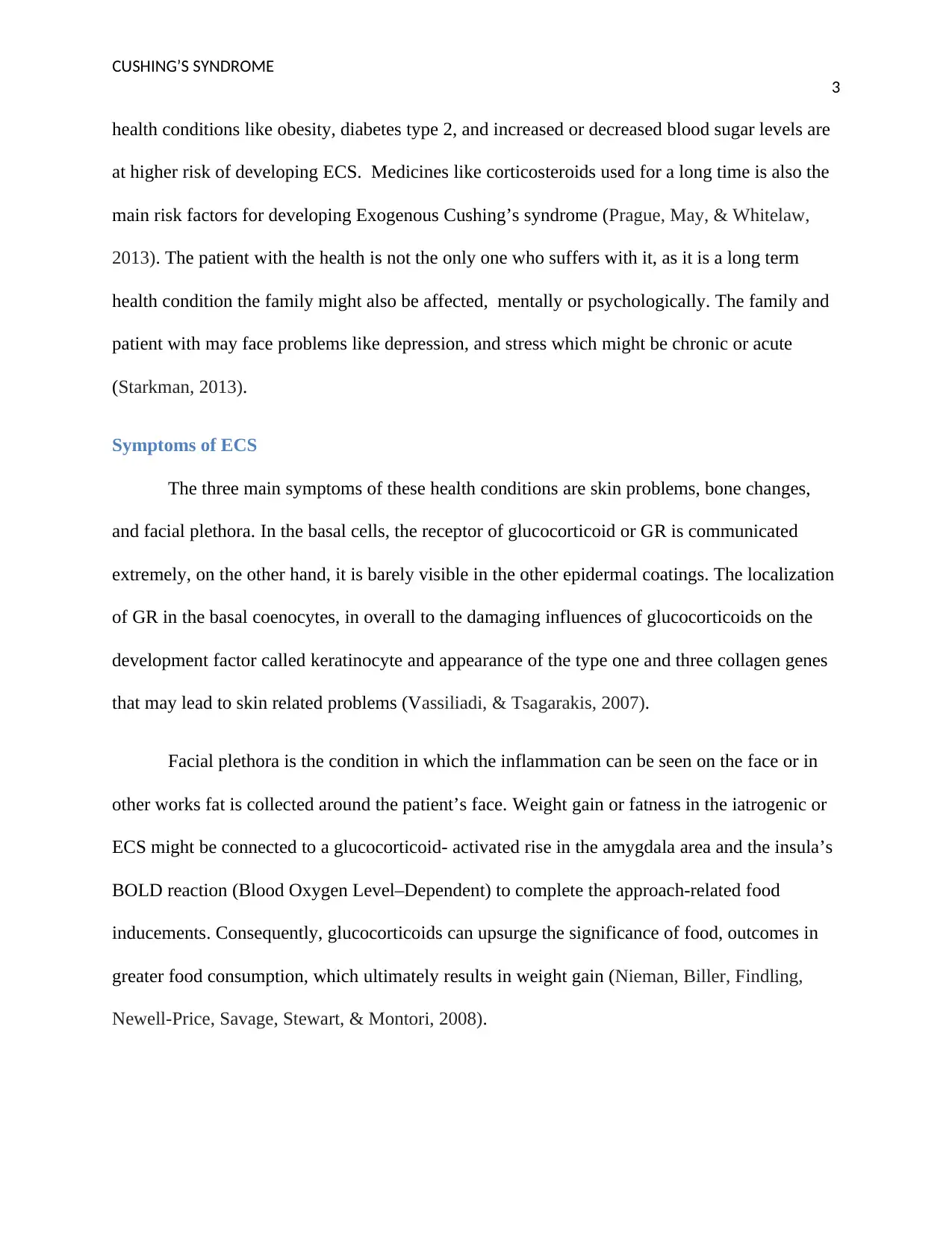
CUSHING’S SYNDROME
3
health conditions like obesity, diabetes type 2, and increased or decreased blood sugar levels are
at higher risk of developing ECS. Medicines like corticosteroids used for a long time is also the
main risk factors for developing Exogenous Cushing’s syndrome (Prague, May, & Whitelaw,
2013). The patient with the health is not the only one who suffers with it, as it is a long term
health condition the family might also be affected, mentally or psychologically. The family and
patient with may face problems like depression, and stress which might be chronic or acute
(Starkman, 2013).
Symptoms of ECS
The three main symptoms of these health conditions are skin problems, bone changes,
and facial plethora. In the basal cells, the receptor of glucocorticoid or GR is communicated
extremely, on the other hand, it is barely visible in the other epidermal coatings. The localization
of GR in the basal coenocytes, in overall to the damaging influences of glucocorticoids on the
development factor called keratinocyte and appearance of the type one and three collagen genes
that may lead to skin related problems (Vassiliadi, & Tsagarakis, 2007).
Facial plethora is the condition in which the inflammation can be seen on the face or in
other works fat is collected around the patient’s face. Weight gain or fatness in the iatrogenic or
ECS might be connected to a glucocorticoid- activated rise in the amygdala area and the insula’s
BOLD reaction (Blood Oxygen Level–Dependent) to complete the approach-related food
inducements. Consequently, glucocorticoids can upsurge the significance of food, outcomes in
greater food consumption, which ultimately results in weight gain (Nieman, Biller, Findling,
Newell-Price, Savage, Stewart, & Montori, 2008).
3
health conditions like obesity, diabetes type 2, and increased or decreased blood sugar levels are
at higher risk of developing ECS. Medicines like corticosteroids used for a long time is also the
main risk factors for developing Exogenous Cushing’s syndrome (Prague, May, & Whitelaw,
2013). The patient with the health is not the only one who suffers with it, as it is a long term
health condition the family might also be affected, mentally or psychologically. The family and
patient with may face problems like depression, and stress which might be chronic or acute
(Starkman, 2013).
Symptoms of ECS
The three main symptoms of these health conditions are skin problems, bone changes,
and facial plethora. In the basal cells, the receptor of glucocorticoid or GR is communicated
extremely, on the other hand, it is barely visible in the other epidermal coatings. The localization
of GR in the basal coenocytes, in overall to the damaging influences of glucocorticoids on the
development factor called keratinocyte and appearance of the type one and three collagen genes
that may lead to skin related problems (Vassiliadi, & Tsagarakis, 2007).
Facial plethora is the condition in which the inflammation can be seen on the face or in
other works fat is collected around the patient’s face. Weight gain or fatness in the iatrogenic or
ECS might be connected to a glucocorticoid- activated rise in the amygdala area and the insula’s
BOLD reaction (Blood Oxygen Level–Dependent) to complete the approach-related food
inducements. Consequently, glucocorticoids can upsurge the significance of food, outcomes in
greater food consumption, which ultimately results in weight gain (Nieman, Biller, Findling,
Newell-Price, Savage, Stewart, & Montori, 2008).
Paraphrase This Document
Need a fresh take? Get an instant paraphrase of this document with our AI Paraphraser
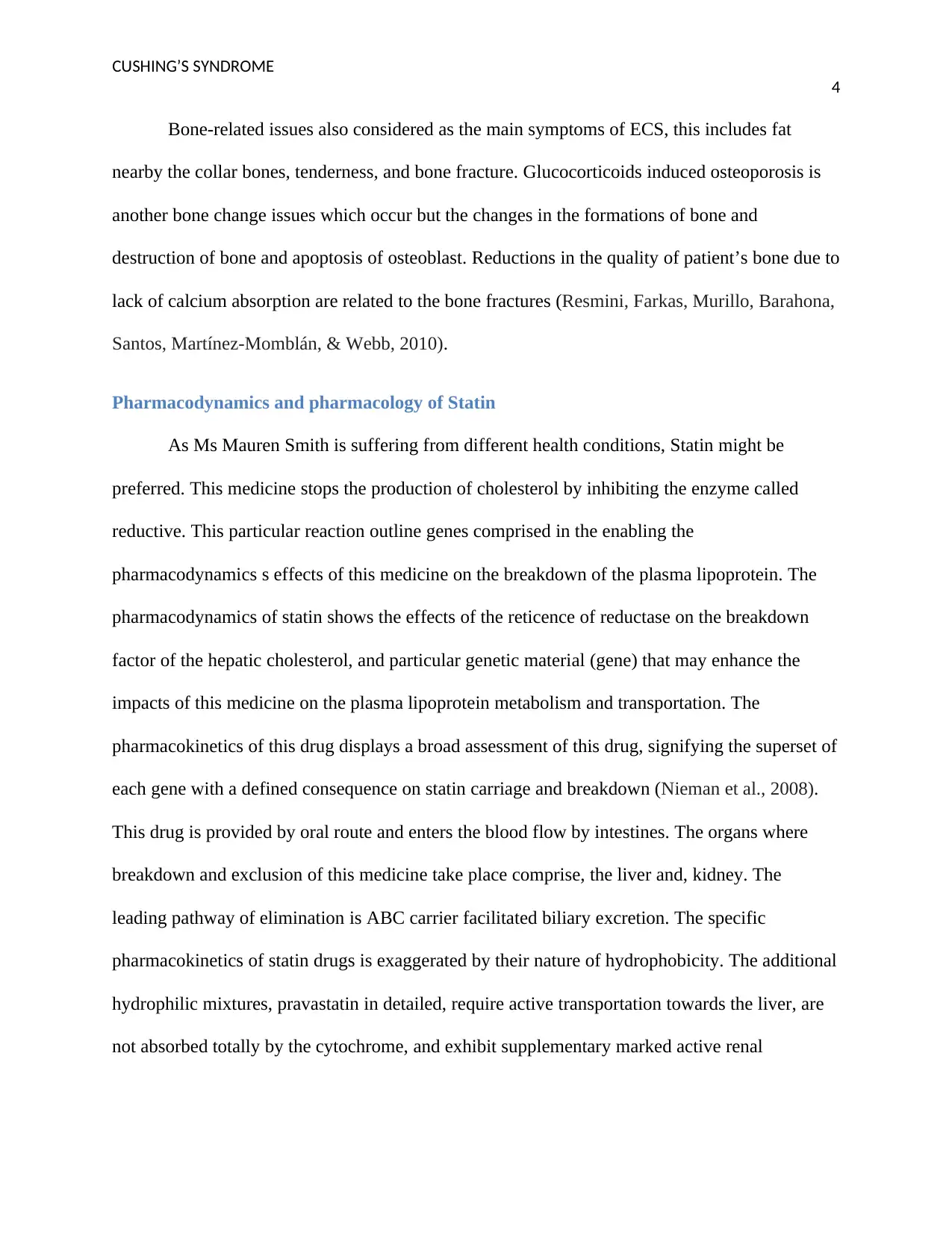
CUSHING’S SYNDROME
4
Bone-related issues also considered as the main symptoms of ECS, this includes fat
nearby the collar bones, tenderness, and bone fracture. Glucocorticoids induced osteoporosis is
another bone change issues which occur but the changes in the formations of bone and
destruction of bone and apoptosis of osteoblast. Reductions in the quality of patient’s bone due to
lack of calcium absorption are related to the bone fractures (Resmini, Farkas, Murillo, Barahona,
Santos, Martínez-Momblán, & Webb, 2010).
Pharmacodynamics and pharmacology of Statin
As Ms Mauren Smith is suffering from different health conditions, Statin might be
preferred. This medicine stops the production of cholesterol by inhibiting the enzyme called
reductive. This particular reaction outline genes comprised in the enabling the
pharmacodynamics s effects of this medicine on the breakdown of the plasma lipoprotein. The
pharmacodynamics of statin shows the effects of the reticence of reductase on the breakdown
factor of the hepatic cholesterol, and particular genetic material (gene) that may enhance the
impacts of this medicine on the plasma lipoprotein metabolism and transportation. The
pharmacokinetics of this drug displays a broad assessment of this drug, signifying the superset of
each gene with a defined consequence on statin carriage and breakdown (Nieman et al., 2008).
This drug is provided by oral route and enters the blood flow by intestines. The organs where
breakdown and exclusion of this medicine take place comprise, the liver and, kidney. The
leading pathway of elimination is ABC carrier facilitated biliary excretion. The specific
pharmacokinetics of statin drugs is exaggerated by their nature of hydrophobicity. The additional
hydrophilic mixtures, pravastatin in detailed, require active transportation towards the liver, are
not absorbed totally by the cytochrome, and exhibit supplementary marked active renal
4
Bone-related issues also considered as the main symptoms of ECS, this includes fat
nearby the collar bones, tenderness, and bone fracture. Glucocorticoids induced osteoporosis is
another bone change issues which occur but the changes in the formations of bone and
destruction of bone and apoptosis of osteoblast. Reductions in the quality of patient’s bone due to
lack of calcium absorption are related to the bone fractures (Resmini, Farkas, Murillo, Barahona,
Santos, Martínez-Momblán, & Webb, 2010).
Pharmacodynamics and pharmacology of Statin
As Ms Mauren Smith is suffering from different health conditions, Statin might be
preferred. This medicine stops the production of cholesterol by inhibiting the enzyme called
reductive. This particular reaction outline genes comprised in the enabling the
pharmacodynamics s effects of this medicine on the breakdown of the plasma lipoprotein. The
pharmacodynamics of statin shows the effects of the reticence of reductase on the breakdown
factor of the hepatic cholesterol, and particular genetic material (gene) that may enhance the
impacts of this medicine on the plasma lipoprotein metabolism and transportation. The
pharmacokinetics of this drug displays a broad assessment of this drug, signifying the superset of
each gene with a defined consequence on statin carriage and breakdown (Nieman et al., 2008).
This drug is provided by oral route and enters the blood flow by intestines. The organs where
breakdown and exclusion of this medicine take place comprise, the liver and, kidney. The
leading pathway of elimination is ABC carrier facilitated biliary excretion. The specific
pharmacokinetics of statin drugs is exaggerated by their nature of hydrophobicity. The additional
hydrophilic mixtures, pravastatin in detailed, require active transportation towards the liver, are
not absorbed totally by the cytochrome, and exhibit supplementary marked active renal
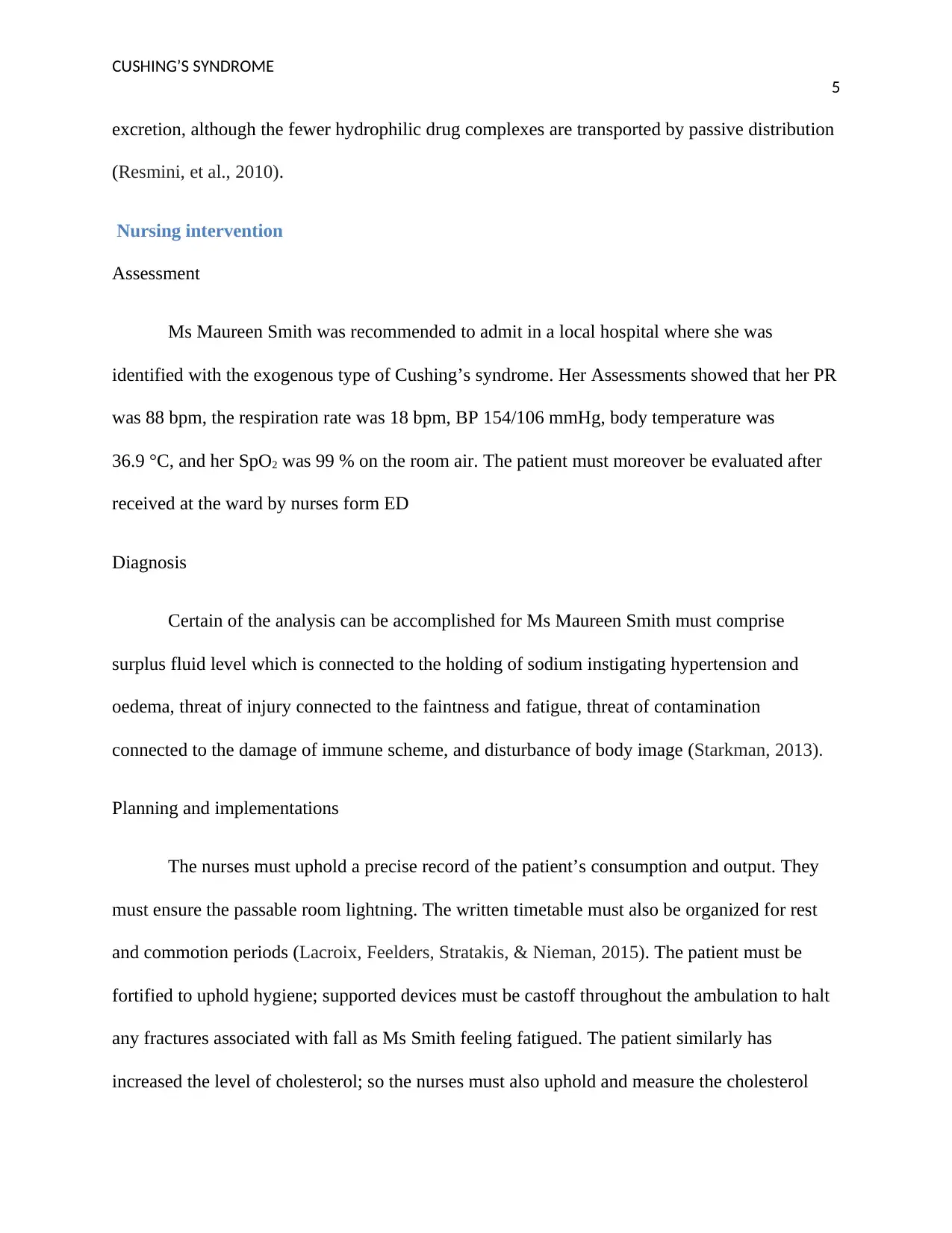
CUSHING’S SYNDROME
5
excretion, although the fewer hydrophilic drug complexes are transported by passive distribution
(Resmini, et al., 2010).
Nursing intervention
Assessment
Ms Maureen Smith was recommended to admit in a local hospital where she was
identified with the exogenous type of Cushing’s syndrome. Her Assessments showed that her PR
was 88 bpm, the respiration rate was 18 bpm, BP 154/106 mmHg, body temperature was
36.9 °C, and her SpO2 was 99 % on the room air. The patient must moreover be evaluated after
received at the ward by nurses form ED
Diagnosis
Certain of the analysis can be accomplished for Ms Maureen Smith must comprise
surplus fluid level which is connected to the holding of sodium instigating hypertension and
oedema, threat of injury connected to the faintness and fatigue, threat of contamination
connected to the damage of immune scheme, and disturbance of body image (Starkman, 2013).
Planning and implementations
The nurses must uphold a precise record of the patient’s consumption and output. They
must ensure the passable room lightning. The written timetable must also be organized for rest
and commotion periods (Lacroix, Feelders, Stratakis, & Nieman, 2015). The patient must be
fortified to uphold hygiene; supported devices must be castoff throughout the ambulation to halt
any fractures associated with fall as Ms Smith feeling fatigued. The patient similarly has
increased the level of cholesterol; so the nurses must also uphold and measure the cholesterol
5
excretion, although the fewer hydrophilic drug complexes are transported by passive distribution
(Resmini, et al., 2010).
Nursing intervention
Assessment
Ms Maureen Smith was recommended to admit in a local hospital where she was
identified with the exogenous type of Cushing’s syndrome. Her Assessments showed that her PR
was 88 bpm, the respiration rate was 18 bpm, BP 154/106 mmHg, body temperature was
36.9 °C, and her SpO2 was 99 % on the room air. The patient must moreover be evaluated after
received at the ward by nurses form ED
Diagnosis
Certain of the analysis can be accomplished for Ms Maureen Smith must comprise
surplus fluid level which is connected to the holding of sodium instigating hypertension and
oedema, threat of injury connected to the faintness and fatigue, threat of contamination
connected to the damage of immune scheme, and disturbance of body image (Starkman, 2013).
Planning and implementations
The nurses must uphold a precise record of the patient’s consumption and output. They
must ensure the passable room lightning. The written timetable must also be organized for rest
and commotion periods (Lacroix, Feelders, Stratakis, & Nieman, 2015). The patient must be
fortified to uphold hygiene; supported devices must be castoff throughout the ambulation to halt
any fractures associated with fall as Ms Smith feeling fatigued. The patient similarly has
increased the level of cholesterol; so the nurses must also uphold and measure the cholesterol
⊘ This is a preview!⊘
Do you want full access?
Subscribe today to unlock all pages.

Trusted by 1+ million students worldwide
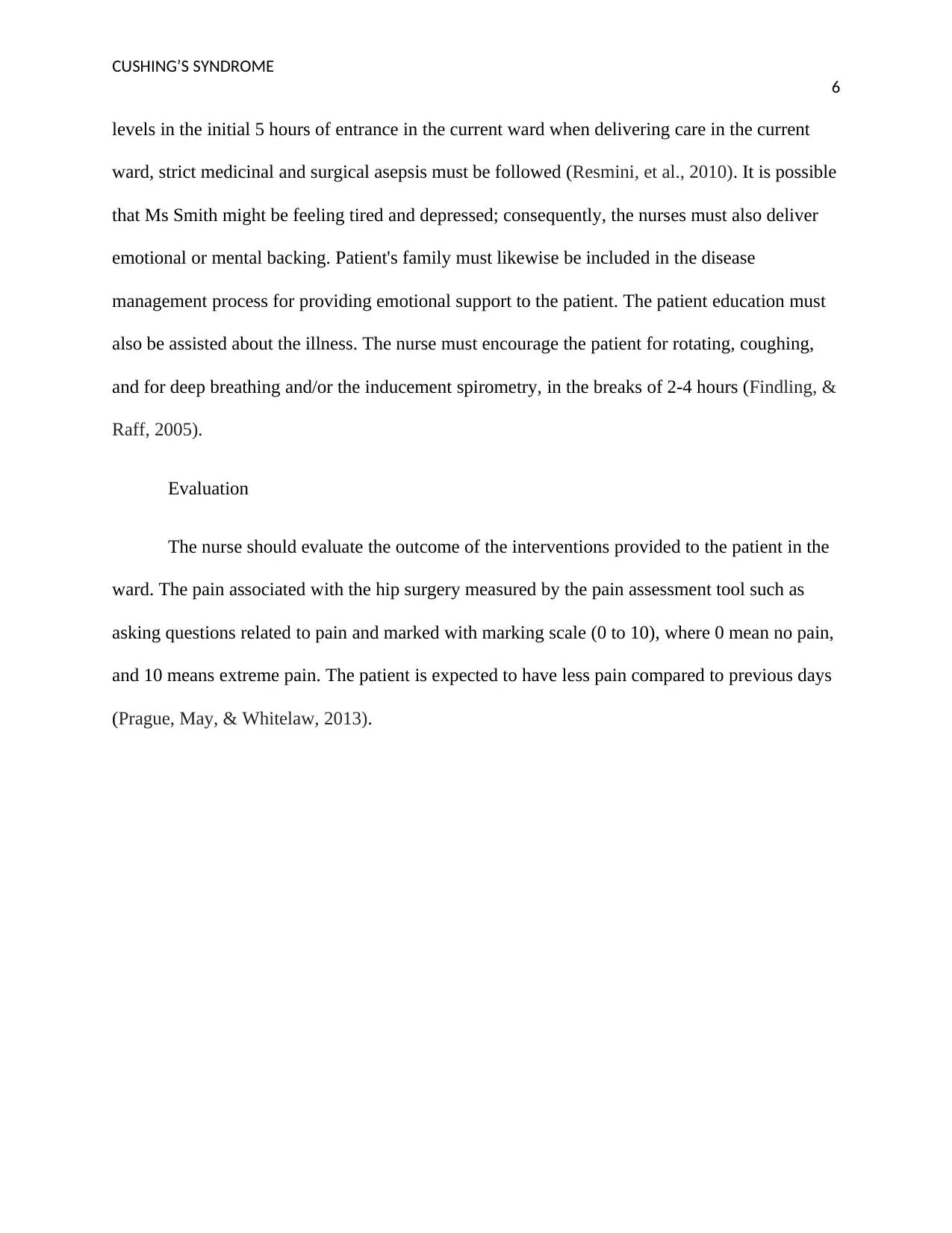
CUSHING’S SYNDROME
6
levels in the initial 5 hours of entrance in the current ward when delivering care in the current
ward, strict medicinal and surgical asepsis must be followed (Resmini, et al., 2010). It is possible
that Ms Smith might be feeling tired and depressed; consequently, the nurses must also deliver
emotional or mental backing. Patient's family must likewise be included in the disease
management process for providing emotional support to the patient. The patient education must
also be assisted about the illness. The nurse must encourage the patient for rotating, coughing,
and for deep breathing and/or the inducement spirometry, in the breaks of 2-4 hours (Findling, &
Raff, 2005).
Evaluation
The nurse should evaluate the outcome of the interventions provided to the patient in the
ward. The pain associated with the hip surgery measured by the pain assessment tool such as
asking questions related to pain and marked with marking scale (0 to 10), where 0 mean no pain,
and 10 means extreme pain. The patient is expected to have less pain compared to previous days
(Prague, May, & Whitelaw, 2013).
6
levels in the initial 5 hours of entrance in the current ward when delivering care in the current
ward, strict medicinal and surgical asepsis must be followed (Resmini, et al., 2010). It is possible
that Ms Smith might be feeling tired and depressed; consequently, the nurses must also deliver
emotional or mental backing. Patient's family must likewise be included in the disease
management process for providing emotional support to the patient. The patient education must
also be assisted about the illness. The nurse must encourage the patient for rotating, coughing,
and for deep breathing and/or the inducement spirometry, in the breaks of 2-4 hours (Findling, &
Raff, 2005).
Evaluation
The nurse should evaluate the outcome of the interventions provided to the patient in the
ward. The pain associated with the hip surgery measured by the pain assessment tool such as
asking questions related to pain and marked with marking scale (0 to 10), where 0 mean no pain,
and 10 means extreme pain. The patient is expected to have less pain compared to previous days
(Prague, May, & Whitelaw, 2013).
Paraphrase This Document
Need a fresh take? Get an instant paraphrase of this document with our AI Paraphraser
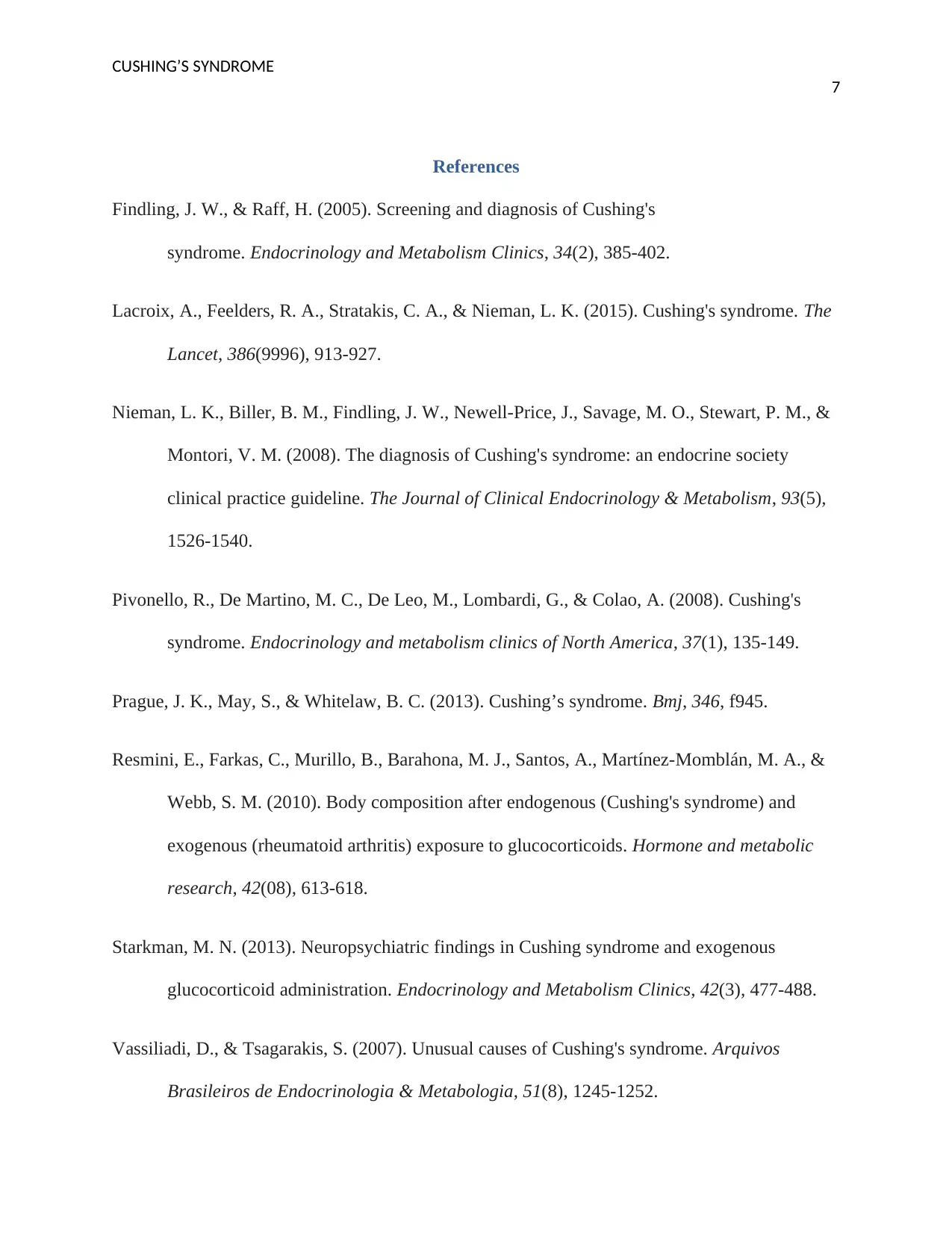
CUSHING’S SYNDROME
7
References
Findling, J. W., & Raff, H. (2005). Screening and diagnosis of Cushing's
syndrome. Endocrinology and Metabolism Clinics, 34(2), 385-402.
Lacroix, A., Feelders, R. A., Stratakis, C. A., & Nieman, L. K. (2015). Cushing's syndrome. The
Lancet, 386(9996), 913-927.
Nieman, L. K., Biller, B. M., Findling, J. W., Newell-Price, J., Savage, M. O., Stewart, P. M., &
Montori, V. M. (2008). The diagnosis of Cushing's syndrome: an endocrine society
clinical practice guideline. The Journal of Clinical Endocrinology & Metabolism, 93(5),
1526-1540.
Pivonello, R., De Martino, M. C., De Leo, M., Lombardi, G., & Colao, A. (2008). Cushing's
syndrome. Endocrinology and metabolism clinics of North America, 37(1), 135-149.
Prague, J. K., May, S., & Whitelaw, B. C. (2013). Cushing’s syndrome. Bmj, 346, f945.
Resmini, E., Farkas, C., Murillo, B., Barahona, M. J., Santos, A., Martínez-Momblán, M. A., &
Webb, S. M. (2010). Body composition after endogenous (Cushing's syndrome) and
exogenous (rheumatoid arthritis) exposure to glucocorticoids. Hormone and metabolic
research, 42(08), 613-618.
Starkman, M. N. (2013). Neuropsychiatric findings in Cushing syndrome and exogenous
glucocorticoid administration. Endocrinology and Metabolism Clinics, 42(3), 477-488.
Vassiliadi, D., & Tsagarakis, S. (2007). Unusual causes of Cushing's syndrome. Arquivos
Brasileiros de Endocrinologia & Metabologia, 51(8), 1245-1252.
7
References
Findling, J. W., & Raff, H. (2005). Screening and diagnosis of Cushing's
syndrome. Endocrinology and Metabolism Clinics, 34(2), 385-402.
Lacroix, A., Feelders, R. A., Stratakis, C. A., & Nieman, L. K. (2015). Cushing's syndrome. The
Lancet, 386(9996), 913-927.
Nieman, L. K., Biller, B. M., Findling, J. W., Newell-Price, J., Savage, M. O., Stewart, P. M., &
Montori, V. M. (2008). The diagnosis of Cushing's syndrome: an endocrine society
clinical practice guideline. The Journal of Clinical Endocrinology & Metabolism, 93(5),
1526-1540.
Pivonello, R., De Martino, M. C., De Leo, M., Lombardi, G., & Colao, A. (2008). Cushing's
syndrome. Endocrinology and metabolism clinics of North America, 37(1), 135-149.
Prague, J. K., May, S., & Whitelaw, B. C. (2013). Cushing’s syndrome. Bmj, 346, f945.
Resmini, E., Farkas, C., Murillo, B., Barahona, M. J., Santos, A., Martínez-Momblán, M. A., &
Webb, S. M. (2010). Body composition after endogenous (Cushing's syndrome) and
exogenous (rheumatoid arthritis) exposure to glucocorticoids. Hormone and metabolic
research, 42(08), 613-618.
Starkman, M. N. (2013). Neuropsychiatric findings in Cushing syndrome and exogenous
glucocorticoid administration. Endocrinology and Metabolism Clinics, 42(3), 477-488.
Vassiliadi, D., & Tsagarakis, S. (2007). Unusual causes of Cushing's syndrome. Arquivos
Brasileiros de Endocrinologia & Metabologia, 51(8), 1245-1252.
1 out of 8
Related Documents
Your All-in-One AI-Powered Toolkit for Academic Success.
+13062052269
info@desklib.com
Available 24*7 on WhatsApp / Email
![[object Object]](/_next/static/media/star-bottom.7253800d.svg)
Unlock your academic potential
Copyright © 2020–2025 A2Z Services. All Rights Reserved. Developed and managed by ZUCOL.





